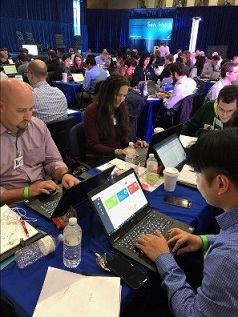HHS Announces Winners of the HHS Opioid Code-a-Thon
 December 8, 2017--On December 6 and 7, HHS hosted a first-of-its-kind two-day Code-a-Thon to help turn data into lifesaving solutions to the opioid epidemic.
December 8, 2017--On December 6 and 7, HHS hosted a first-of-its-kind two-day Code-a-Thon to help turn data into lifesaving solutions to the opioid epidemic.
Fifty teams, comprised of three to five members of computer programmers, public health advocates, and innovators worked for over 24 hours to create data-driven solutions that can have immediate and practical impact on the opioid crisis.
“HHS’ code-a-thon was a major step forward in the efforts to use data to address the opioid crisis,” said Acting HHS Secretary Eric Hargan. “The innovative ideas developed today could turn into tomorrow’s solutions as we work to combat the scourge of opioid addiction sweeping the nation. On behalf of the administration, I commend all of our technology partners and the HHS staff for their hard work on this unprecedented event.”
 HHS Opioid Hackathon CodersHHS Chief Technology Officer Bruce Greenstein said, “We put the call out across the tech and entrepreneur communities to join us in Washington, D.C., so that we might multiply our combined skills and resources to combat the opioid epidemic. Over 300 coders answered the call and 50 teams joined us at HHS Headquarters to create a community that will continue to use data and technology to develop new solutions to address the epidemic.”
HHS Opioid Hackathon CodersHHS Chief Technology Officer Bruce Greenstein said, “We put the call out across the tech and entrepreneur communities to join us in Washington, D.C., so that we might multiply our combined skills and resources to combat the opioid epidemic. Over 300 coders answered the call and 50 teams joined us at HHS Headquarters to create a community that will continue to use data and technology to develop new solutions to address the epidemic.”
Teams used data from HHS and other federal agencies, some of it released for the first time, to analyze trends and patterns and propose solutions in three challenge areas.
Out of the 50 teams competing, nine teams were selected for the final judging round. The three winners that were awarded $10,000 prizes are:
- In the prevention track coders were asked, “How can you help federal, state, and local stakeholders predict and analyze the supply and movement of legal and illicit opioids?” The Visionist Inc. team came up with a program called Take Back America, to assess the unmet need in five states for takeback programs at pharmacies where unused or unneeded opioids can be returned, therefore taking a source of opioids out of circulation.
- In the treatment track coders were asked, “How can you help federal, state, and local stakeholders improve access to effective treatment and recovery services?” The Origami Innovations team, from Yale University, produced a model designed for real-time tracking of overdoses, allowing first responders and health authorities to be prepared for tracking events such as an outbreak of fentanyl overdoses in communities. This real time tracking would enable area hospitals and local health departments to allocate resources where they are most needed.
- In the usage track coders were asked, “How can you help federal, state, and local stakeholders identify at-risk populations and their underlying risk characteristics of opioid misuse or abuse?” The Opioid Prescriber Awareness Tool (OPAT) team developed a program to provide physicians with a visual representation of their opioid prescribing patterns compared with their peers. The tool also allows physicians to visualize the prescribing patterns of other physicians in their area that they might refer their patients to.
- Tags:
- Bruce Greenstein
- data-driven solutions
- Eric Hargan
- fentanyl overdoses
- HHS Opioid Code-a-Thon
- open health
- open source software (OSS)
- opioid addiction
- Opioid Crisis
- opioid epidemic. computer programmers
- Opioid Prescriber Awareness Tool (OPAT)
- opioid prescribing patterns
- Origami Innovations team
- public health advocates
- real time tracking
- Take Back America
- US Department of Health and Human Services (HHS)
- Visionist Inc team
- Yale University
- Login to post comments